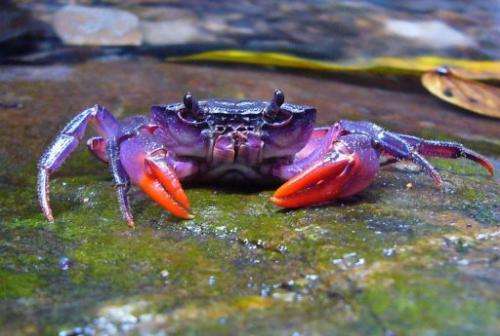New purple crab species found in Philippines

Four new species of freshwater crab, bright purple in colour, have been discovered in the biologically diverse but ecologically-threatened Philippines, the man who found them said Saturday.
The tiny crustaceans burrow under boulders and roots in streams, feeding on dead plants, fruits, carrion and small animals in the water at night, said Hendrik Freitag of Germany's Senckenberg Museum of Zoology.
Found only in small, lowland-forest ecosystems in the Palawan island group, most have purple shells, with claws and legs tipped red.
"It is known that crabs can discriminate colours. Therefore, it seems likely that the colouration has a signal function for the social behaviour, e.g. mating," Freitag told AFP by email on Saturday.
"This could explain why large males of various Insulamon species are more reddish compared to the generally violet females and immature males."
Scientists began extensive investigations of similar freshwater crabs in the area in the late 1980s, when one new species was found -- the Insulamon unicorn, Freitag said.
More field work led Freitag to conclude there were four other unique species.
"Based on available new material, a total of five species are recognised... four of which are new to science," Freitag wrote in the latest edition of the National University of Singapore's Raffles Bulletin of Zoology.
The carapace of the biggest, Insulamon magnum, is just 53 millimetres by 41.8 millimetres while the smallest, Insulamon porculum, measures 33.1 by 25.1 millimetres.
The two other new species were called Insulamon palawense and Insulamon johannchristiani.
The four slightly differ from the first find, and from each other, in the shapes of their body shells, legs, and sex organs.
US-based Conservation International lists the Philippines as one of 17 countries that harbours most of Earth's plant and animal life.
Reptiles, birds or mammals likely prey on the crabs, and it is possible people in remote areas also collect them for food, Freitag said.
However, the main threats are the ongoing forest clearing for farming, mining or home building, since this risks drying up their small habitats and causes water pollution, he said.
"Even if the habitats are not entirely destroyed, the smaller the remaining habitats, the higher the risk of extinction for a species," he said.
(c) 2012 AFP
















